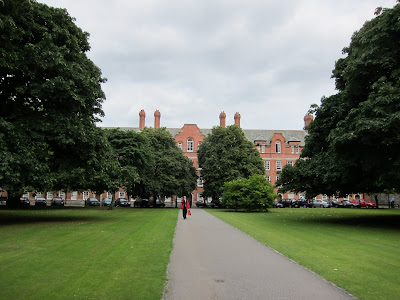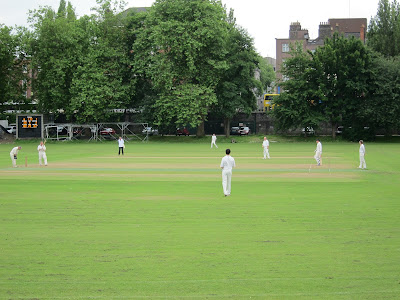Yesterday, I had lunch with Leila Crawford, a fellow Eph and Hibernophile. Leila is interning at the James Joyce Centre this summer, and is single-handedly responsible for making me infamous at the JJC: when I called last week to book my tickets for the Bloomsday festivities, I spoke to another American intern and asked her "Do you know Leila?" and she said said she didn't know how that was. Turns out, Leila was sitting right next to her at the time, and the girl was pretty embarrassed about that. The story spread around throughout the centre to the extent when I arrived on Tuesday and asked at the front desk, "is Leila here?" the gentleman responded "Oh, you must be the friend." After that, everyone knew who I was... it was pretty weird but funny.
Anyway, we had lunch at a nice cafe called "The Queen of Tarts" on Dame Street, which is in the Temple Bar District next to Trinity College. Leila has traveled to Ireland twice before, and had lots of good advice about who I could contact in Ireland to help me with my research.
After lunch, we walked down O'Connell street and stopped by the historic General Post Office. During the Easter Rising of 1916 (if you're not familiar with the Easter Rising, check out the Wikipedia article on it- it's really interesting, and an critical turning point in modern Irish history), the GPO became the headquarters of the Irish forces. The British forces heavily attacked the headquarters, and you can still see the bullet holes in the columns (see below).

At first, I hated the buses in front of the GPO in this picture, but then I realized that it's a good example of the juxtaposition between old and new that you constantly see in Dublin. There are beautiful examples of Medieval and Georgian architecture throughout the city that are alongside more modern structures. The city experienced a tremendous amount of growth, prosperity and modernization in the Celtic Tiger era.
We also passed Davy Byrnes, the place where Bloom has lunch- a gorgonzola sandwich and a glass of Burgundy. Before I leave Dublin, I solemnly swear to do the same.

Leila and I decided to stop by the Dublin Writers Museum. The museum is a small, two room exhibit, but it is a loving and thoroughly informative tribute to the many great Irish writers over the centuries.
Ok, here's where I have to give my passionate spiel about Irish literature. For a country so small, Ireland has an overwhelmingly impressive line-up of distinguished writers, a literary tradition that is unmatched by most countries twice its size. Ireland has four Nobel Prize Laureates in Literature: William Butler Yeats, George Bernard Shaw, Samuel Beckett, and Seamus Heaney. That excludes Joyce, who literally revolutionized the novel with Ulysses, but whose achievement wouldn't even be considered by the Nobel Committee because the book was too dirty.
I learned about Maria Edgeworth, who wrote one of the first realist novels and was the first author (male or female) to write an Irish novel about common people in Ireland.
I didn't realize that Bram Stoker, author of Dracula was Irish. The Irish may or may not be responsible for Twilight (shudder).
Don't forget Jonathan Swfit, author of Gulliver's Travels, Oscar Wilde and many others.
There were also some beautiful stories, like the story of Joyce and Beckett. Joyce was in exile in Paris, working on Finnegans Wake when he befriended a young Samuel Beckett. Joyce's eyesight was failing-he always had poor eyesight, which is why the language in Ulysses is so attentive to the sounds of words- he responded to language very much in an auditory way. Now nearly blind, Joyce dictated to Beckett who tirelessly helped him finish his last great work. Finnegans Wake is basically incomprehensible, and for those of you who are familiar with Beckett's work, Joyce's influence is definitely there.
I wasn't allowed to take pictures in the exhibit, but on the way out I saw this painting of Joyce, which I thought was pretty cool:
In the evening, I went to see a production of Oscar Wilde's The Importance of Being Earnest at Gaiety Theatre, which is off of Grafton Street. All the advertisements promoted Stockard Channing as Lady Bracknell. Turns out that Dublin suffers from the same syndrome as New York: Hiring-actors-just-because-they-have-a-name-and-they-want-to-sell-tickets-itis. Sorry Rizzo, but you totally sucked the energy out of every scene.
In all seriousness, the rest of the cast was strong. Channing's Bracknell was perhaps misdirected, or she just needed a little more help acclimating to the script and her Irish castmates.
The set consisted of several tacky painted rotating panels on metal scaffolding. During the big setting change, the butler (who was somewhat dressed like a clown) came out on rollar skates to move the panels and drop a swing set. As eloquently stated in the Irish Times review, this was an interesting moment but nothing was really done with it after that. Initially, I had mixed feelings about this set-- the strong, contemporary geometry of the panels seemed to clash with the vibrant period dress, and their tackiness was perplexing. Once the set changed it made more sense-- perhaps they were using the panels to suggest that in the world of the play society is a kind of tacky artifice, a dynamic construct in which identities are ever-changing and fluid. But I'm not sure this worked as it might have been intended.
Still, Wilde's wit is as biting at ever. What he suggests about the differences between men and women, how so much of what we do is a shallow act just to keep up appearances, about the uncertainty of our identities in this world, etc. is a kind of satire that is just as relevant today as when it was first written.
In the lobby of the theatre, they sell popcorn and soda like in a movie theatre. They also have vendors who walk down the aisles during intermission selling ice cream. The same is true of most theatres in London- weird!

The interior of the Gaiety is quite intimate and beautiful.
This afternoon, I went on a tour of Trinity College. The tour guide spoke a lot about the history of the college and stories behind the different buildings. I am definitely biased toward Williams tours, which are much more personal and far more about the student experience. Nevertheless, it was a fun and informative tour.
The front gate from inside Trinity.
Some of the residential halls.
The tour ended at the Trinity College Library, which houses the Book of Kells, Ireland's great national treasure. The Book of Kells is an illuminated manuscript-one of the finest in the world-- written by Celtic monks around 800 AD. I had heard that seeing it in person was a little anti-climatic, but I found it interesting to be able to see it up so close. I also went to the library's Long Room, which houses their rarest books, and saw an original copy of the 1916 Proclamation of the Irish Republic. Naturally, they wouldn't let me take pictures...
Outside the Trinity College Library.
Walking back, I saw these guys playing cricket. Is it cricket? I don't even understand American sports, so there's no hope that I'll understand Irish cricket. However, I did stay and watch for a brief while- hurray for expanding one's cultural horizons!








Oh, the narration of this day's blog is fantastic! I felt like I was there.....especially love the look of the Gaiety and your critique of the play....hope you are feeling great. Miss you...Mom
ReplyDeletei'm so glad you've finally seen the importance of being earnest, even if the production was meh.
ReplyDeletei'm currently sitting in bed, unable to move from the soreness created by yesterday's african dance class. oy.
I miss the British custom of ice cream during intermission so much! I really wish someone would import that tradition to the U.S....sigh.
ReplyDelete-David
Amen David!
ReplyDelete